
Original Link: https://www.anandtech.com/show/2277
Low Power Server CPU Shoot-out
by Jason Clark & Ross Whitehead on July 17, 2007 12:15 AM EST- Posted in
- IT Computing
In previous server processor reviews, we've always covered the mainstream processor SKUs. Today, we're going to take a look at the low voltage parts that both AMD and Intel offer. Intel uses the LV nomenclature for their low voltage parts, and AMD uses HE to designate their low voltage parts. Both Intel and AMD have been shipping low voltage parts for a few years now, but it hasn't been until recently that these parts have started to see some growth in the industry.
The first question you may ask yourself is, "What makes a low voltage part?" A standard Intel Xeon (Woodcrest) is rated at 80W TDP, and their low voltage parts are rated at 40W TDP. Most of AMD's Opterons operate at 85W TDP and their low voltage parts come in at 68W TDP. At first glance, it would appear that Intel servers should utilize less power than AMD, but that would be an incorrect assumption. Given the many components that make up a server (especially memory), and the difference in how each vendor handles their different power states, there is more to low voltage than meets the eye.
If you've kept up with environmental and energy sector news, it's no wonder that low voltage parts are starting to gain traction in the market place. Energy costs are on the rise, data centers are out of power, and corporations with large-scale server deployments are looking to cut operating costs wherever they can. In one of the MySpace architecture videos from MIX, the CTO of MySpace detailed the evolution of their architecture; he stated that as low voltage processor parts come out they are buying them as quickly as possible. Obviously MySpace is in that percentage of corporations with a massive amount of servers deployed in data centers (6000 web servers to be exact) as detailed in a recent video from MIX07.
Due to the popularity of low voltage parts, getting a common server configured with low voltage processors is painless. Take Dell for example: when you customize a Dell PowerEdge 1950, you have the choice of regular parts or LV. Cost-wise, an LV part will tack another $350 US onto your total bill as of July, 2007. As for an equivalent AMD system, the Dell PowerEdge 1435 allows the same selection of low voltage parts, and that will tack another $200 on to your total bill. So, buying these parts is easy, and by pure technical specifications they appear to have the ability to save you some serious money. Read on, and we'll give you information that should help you decide for yourself if low voltage parts are in your future.
Benchmarking Low Voltage
In our last review we tested with Power Management features turned off, and also with them turned on. Since this article is focused on low power parts, and the industry is mostly focused on Performance/Watt, we decided we would only report results with all Power Management features enabled.
To configure our servers with all Power Management features on, we perform the following:
On Intel
In the BIOS ensure that Thermal Management is On/Enabled, C1 Enhanced Mode is On/Enabled, and EIST Support is On/Enabled.
On AMD
In the BIOS ensure that PowerNow is On/Enabled. Additionally, you must install the Processor Driver, from AMD, in your OS.
For both platforms you must also set the Power Options in Control Panel to "Server Balanced Processor Power and Performance".
We wanted to measure the impact that the Power Management features had on a system at idle. The following graph shows the results.
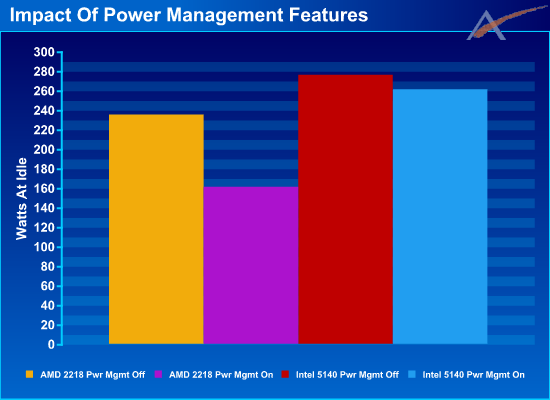
With all Power Management features turned on, the AMD system uses 31% less power at idle than with the Power Management Features turned off. The Intel system on the other hand only uses 5% less with all Power Management features turned on, and this is still 62% more power than the AMD system.
More on this later; first we want to explore the benefit on system power that the low power parts have. With all Power Management features turned on we recorded idle power usage for the same clocked parts for the regular and low power parts.
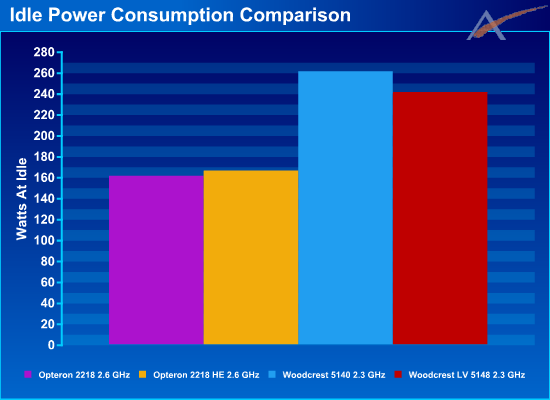
In the case of AMD, the low power parts actually consume 5 more watts, 2.5 watts/socket. We verified this a few times, and each time the results were consistent. We discussed this with AMD, and they were more concerned with the power consumption results under load, which we will get to in a few slides.
In the case of Intel, the low power parts use 20 watts less, 10 watts/socket. Again, this is at idle.
At the system level, the best savings at idle is only 8%. Is that consistent with what we will see under load? We will look at that shortly to find out.
During the testing, we often speculate about where all the power goes. We attempted to find out by measuring power consumption of the entire system at idle, then removing a component and re-measuring the power consumption. The difference in power can be attributed to the removed component. This is not a perfect way to determine component power requirements, but it does provide some general guidance as to where all of the power goes. The results are very interesting:
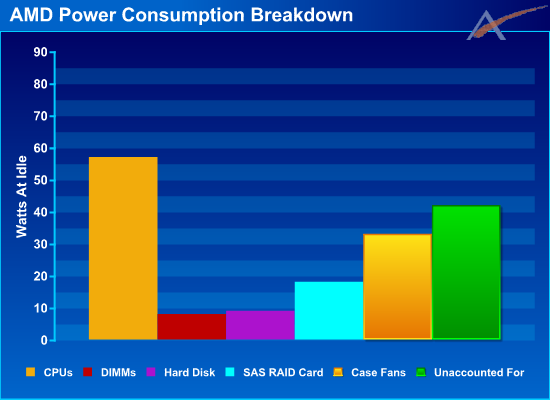
In the AMD system we see that the bulk of the power is consumed by the idle CPUs. Overlooking the "Unaccounted For", the next biggest consumer is the 5 case fans, followed by the SAS RAID Card. The "Unaccounted For" is everything which is not listed, including the inefficiency of the power supply and the motherboard and chipset.
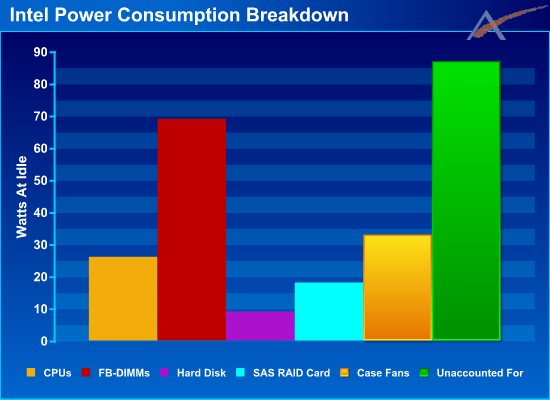
In the Intel system we see that the CPUs require significantly less power than the AMD CPUs, 54% less to be exact. On the other hand the FB-DIMMs require 862% more power than the AMD DIMMs. (Yikes!) Also, the "Unaccounted For" is twice as much on the Intel system as the AMD system. Keep in mind both of these systems have identical power supplies, so the efficiency is roughly the same.
Choosing the contenders
In previous articles, we've been asked to explain why we chose the parts we did for an article. For this article we used the highest clocked low power parts from both Intel and AMD, and equally clocked regular power parts for comparison. With equally clocked parts, it allows us to see that there is virtually no performance difference between low voltage parts and regular voltage parts. It also allows us to clearly determine the power savings of low power processors.
Quest Benchmark Factory
Benchmark Factory for Databases is a performance and code scalability testing tool that simulates users and transactions on a database and replays a production or synthetic workload in non-production environments. This enables organizations to validate database scalability as user loads increase, application changes are made, and platform changes are implemented. Benchmark Factory is available for Oracle, SQL Server, DB2, Sybase, MySQL, and other databases via ODBC and Native connectivity.
Benchmark Factory provides many tests you can run, and has a very nice and customizable metric reporting engine. We decided to run the AS3AP test, and the Scalable Hardware CPU, Reads, and Mixed tests. Here is what Quest's help file says about these tests:
AS3AP
The AS3AP benchmark is an American National Standards Institute (ANSI) Structured Query Language (SQL) relational database benchmark. The AS3AP benchmark provides the following features:
- Tests database processing power
- Built-in scalability and portability that tests a broad range of database systems
- Minimizes effort in implementing and running benchmark tests
- Provides a uniform metric and straightforward interpretation of benchmark results
Scalable Hardware
The Scalable Hardware benchmark measures relational database systems. This benchmark is a subset of the AS3AP benchmark and tests the following:
- CPU
- Disk
- Network
- Any combination of the above three entities
Test Setup
Both of our systems are in an identical chassis, with identical power supplies. The systems differ only in the motherboard/CPU/memory and in their fan setup. Intel Xeon systems typically use a ducted system as you can see below, whereas AMD uses a conventional heatsink w/fan.
Socket-F System
The Socket-F system has two 2.6GHz (2218/2218HE) processors mounted on a Tyan S3992 main board, with 8x1GB of DDR2-667 OEM memory. Internal cooling consists of five 3.5" fans and two CPU fans. Internal storage is provided by one WD1600YD hard drive, which is where the OS is installed.
Woodcrest System
The Woodcrest system is configured with two 2.33GHz Xeon 5140/5148 processors, seated in a SuperMicro X7DBE+. The Woodcrest system is outfitted with 8x1GB 667 MHz OEM FB-DIMMs. Internal cooling consists of five 3.5" fans, with plastic ducting directing airflow across the CPUs and FB-DIMMs (shown below). Internal storage once again comes from one WD1600YD hard drive with the OS installed.
 Socket F Server |
 Woodcrest Server |
RAID Storage
LSI Logic 8480E MegaRaid Controller
Promise VTRAK J300s SAS Chassis
12 x 146GB Fujitsu 15,000 RPM SAS Drives configured in RAID 0
Operating System/Software
Windows 2003 Enterprise SP2 x64
SQL 2005 Enterprise x64 SP2
ASAP Transactions/sec
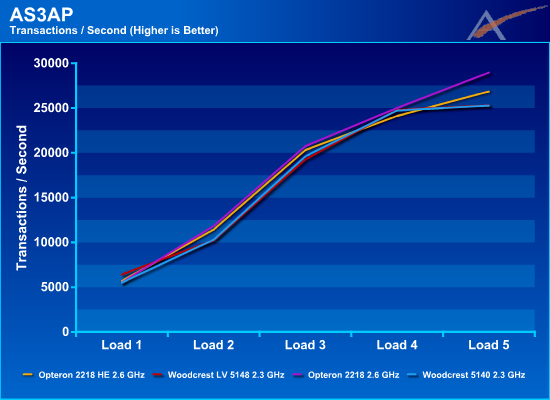
There is almost no performance difference between the low power parts and their equivalent regular parts. The maximum deviation between the AMD parts is 8% and 2% for Intel. This is a good thing as it indicates that the lower power parts do not come at a performance premium.
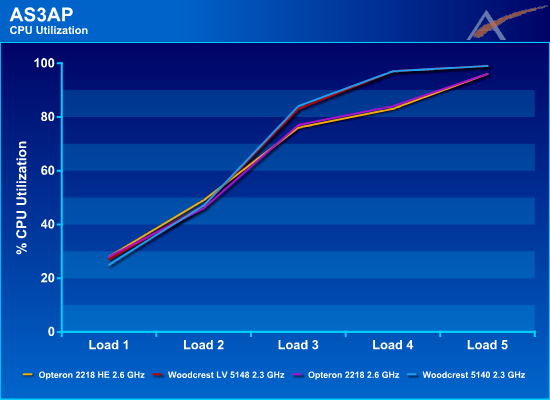
Again, there is almost no difference between the low power parts and the regular parts from the same manufacturer.
ASAP Power
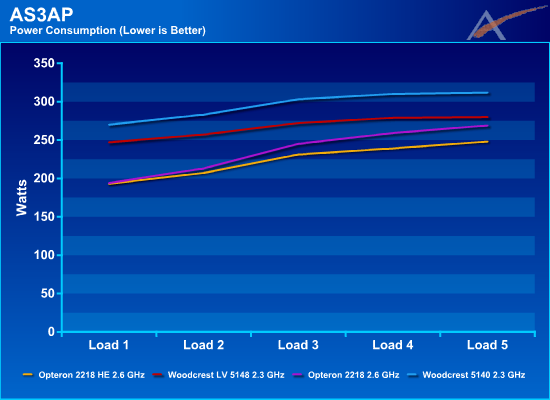
We see here that the Intel configurations use significantly more power than the AMD configurations. The Intel low power setup uses as much as 40 watts more power than the AMD lower power system. Recall however that FB-DIMMs from the Intel system use approx. 60 more watts than the DIMMs in the AMD system, so the difference is in the platform rather than in the CPUs.
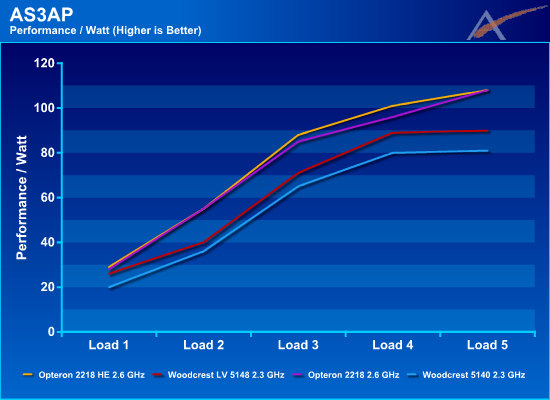
Here we see that the AMD systems are very similar, and clearly the leader in Performance/Watt. That the AMD systems are so similar is quite surprising... not really what we expected for low power parts! With the Intel systems we see a noticeable difference between the two, with the low power parts performing as expected.
Scalable Hardware CPU (Transactions/sec)
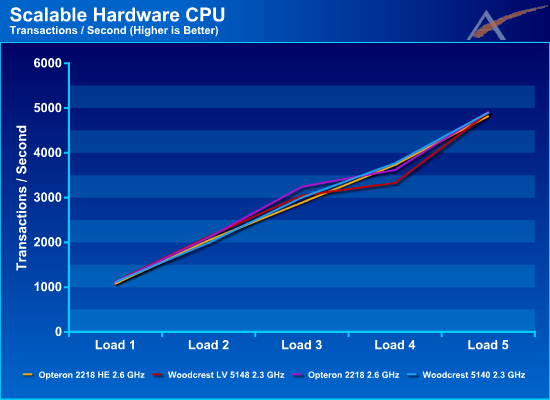
Once again, we get very similar results.
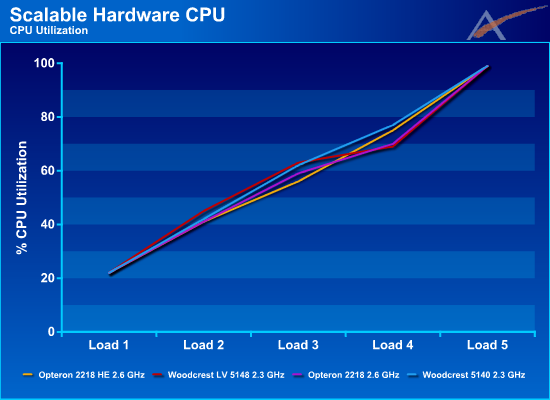
Everything is mostly linear here as we would expect. The AMD parts take an unexplainable little dip at the fourth load point.
Scalable Hardware CPU (Power)

The power results are similar to what we've seen already, with AMD being the clear winner but not much difference between the low power and regular power parts.
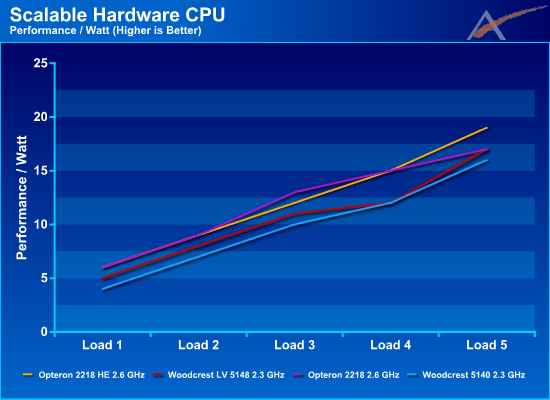
AMD is again the clear winner here, but they do not lead by as much in this test as they did in the AS3AP test.
Scalable Hardware Mixed (Transactions/sec)
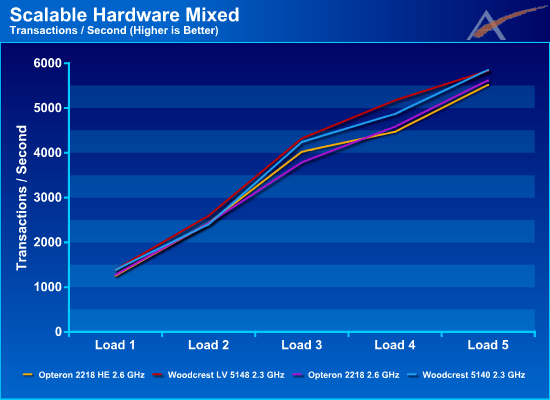
In this test we see that the Intel low power parts are the clear leader.
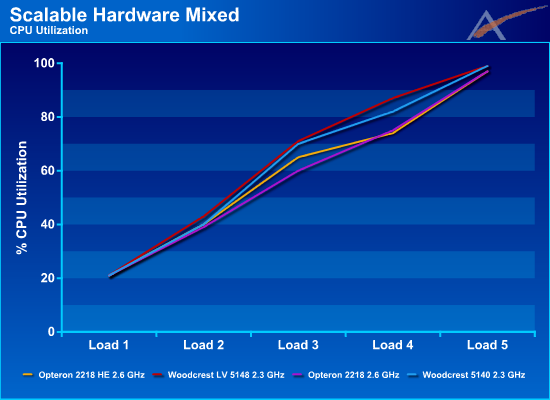
The Intel low power part has the highest transactions/second and the highest CPU utilization also. There's no surprise there, as higher transaction rates require more CPU power.
Scalable Hardware Mixed (Power)
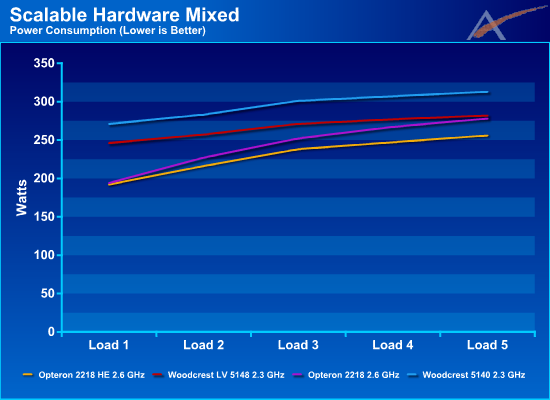
Power results continue to be similar to our previous tests.
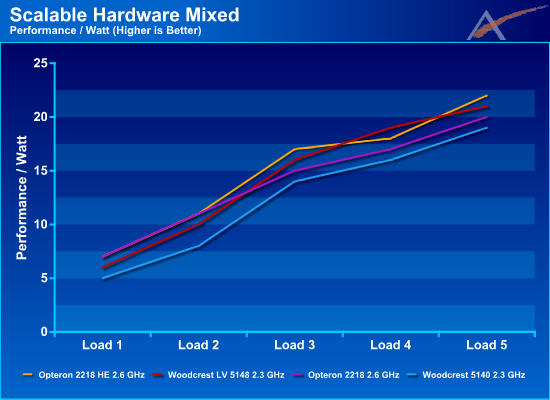
In this test the race is much closer. Intel's low voltage is able to take load point 4.
Scalable Hardware Reads (Transactions/sec)
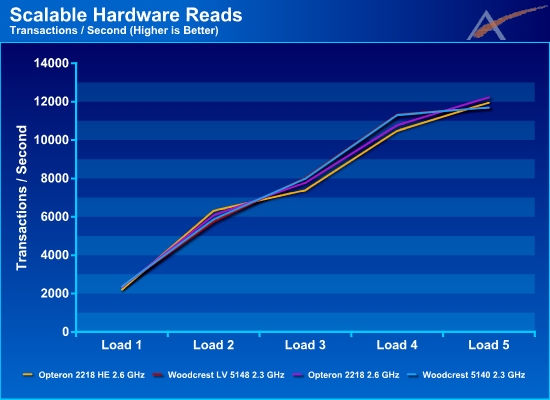
A very tight race again...
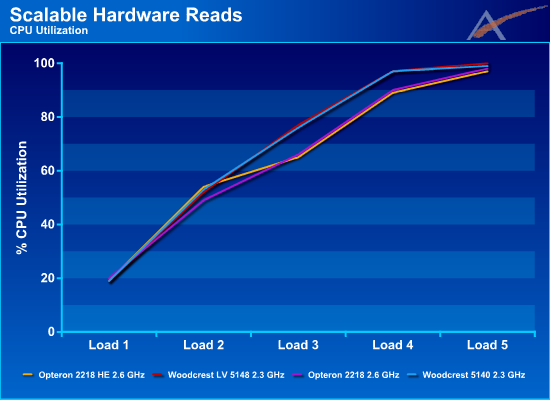
...with similar CPU Utilization to the previous tests.
Scalable Hardware Reads (Power)
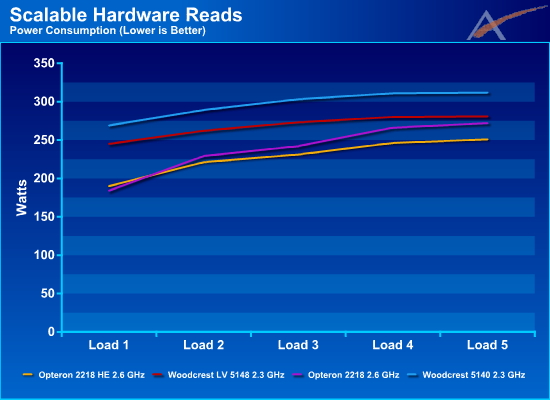
Power Consumption results continue the patterns seen in the previous tests.

Again, AMD is able to clearly win the Performance/Watt race with little difference between its low power and regular power parts.
Conclusion
Power is on everyone's mind these days and rightfully so. The cost of operating and cooling the average server is certainly not cheap, and is on the rise year over year. The question is whether the CPU is the component under the hood that is utilizing the majority of total system power or not. The answer to that question should be clear: the CPU is just a piece of the puzzle. Memory, fans, chipset, drives, HBAs, etc. all play a role in utilizing power.
AMD is clearly the leader when it comes to performance per watt using the workloads in this article. What is interesting to note is that AMD's advantage isn't at the processor level, but instead it's related to the fact that they don't use fully buffered DIMMs. Obviously, the measurements we took of each component aren't precise - it's just about impossible to do that (at least without sophisticated equipment). However, we can safely draw the conclusion that there is a lot more to power consumption than the CPU itself.
So should you run out and upgrade all of your servers to low voltage processors? We certainly can't answer that question without understanding your server workloads, budget, etc. If a few watts will make a large impact on your total operating cost, then the few hundred dollars per box may be justified. However, we think that more organizations should be thinking about power in terms of utilization.
How many of your servers are sitting around idling 90% of the time? Studies indicate that the average utilization of a PC based server is approximately 7%. Instead of investing a few hundred dollars in saving a few watts, why not try server consolidation? As you have seen the majority of system power is used just to run the fans, chipset, CPU, etc. when the server is at idle. If you could take two systems that consume 300 watts of power and combine them into one server, isn't that worth more to your organization? Take a look at VMWare, XenSource, and other virtualization solutions, if you really want to lower operating costs relating to power consumption.







